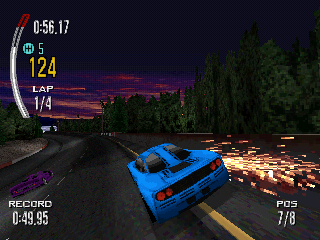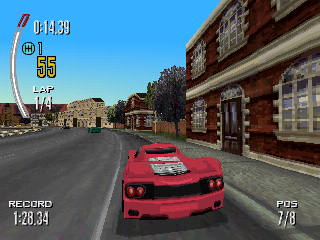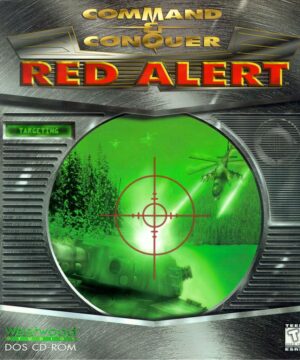Retro Replay Review
Gameplay
Need for Speed II places you behind the wheel of eight iconic supercars, including the McLaren F1, Ferrari F50, Lotus GT1, Jaguar XJ220, Ford GT90, Isdera Commendatore 112i, Italdesign Cala and Lotus Esprit V8. Each vehicle offers a distinct handling profile and top speed, making the choice of car as crucial as the track itself. Whether you favor the razor-sharp agility of the Lotus or the raw power of the Ferrari, you’ll find that mastering each machine is both a challenge and a reward.
(HEY YOU!! We hope you enjoy! We try not to run ads. So basically, this is a very expensive hobby running this site. Please consider joining us for updates, forums, and more. Network w/ us to make some cash or friends while retro gaming, and you can win some free retro games for posting. Okay, carry on 👍)
The game offers three distinct modes: Single Race, Tournament, and Knock Out. In Single Race, you can pick any track and car combination to hone your skills. Tournament mode tasks you with accumulating the highest points across the board to emerge as the champion, while Knock Out forces you to finish each heat ahead of at least one rival or face elimination. This tiered structure provides a satisfying sense of progression and keeps the competition fierce.
Customization is a core strength of the gameplay. You can tweak gear ratios for faster acceleration or higher top speeds, adjust downforce to balance cornering grip, and shift brake bias for more responsive braking. Beyond performance, you can even select your car’s paint job and livery. Opponent skill levels and the presence of civilian traffic are adjustable as well, so you can dial up the intensity or ease up for a more leisurely drive.
Need for Speed II also caters to both arcade purists and simulation enthusiasts. Choose Arcade mode for snappier handling and less punishment on mistakes, or switch to Simulation mode if you want realistic physics, tighter controls, and a true test of your racing prowess. This flexibility ensures that newcomers and veterans alike can find a playstyle that suits them.
Racing across six exotic tracks—from the sun-bleached roads of Australia to the winding mountain passes of Nepal—each course feels unique. Beat the initial six tracks to unlock a bonus circuit, pushing your mastery of each car and environment. The absence of police chases, a hallmark of the original Need for Speed, puts the spotlight squarely on pure racing action.
Graphics
Released during the late 1990s, Need for Speed II pushed the boundaries of polygonal graphics on contemporary hardware. The models for each supercar are impressively detailed for the period, capturing the sleek curves and aggressive angles that define these automotive legends. Paint reflections and shiny chrome accents really pop, giving you a visceral sense of driving a high-end machine.
The tracks themselves are varied in visual style. Desert dunes and palm-lined highways in Australia give way to dense forests, coastal roads, and even snow-capped passes. Changing weather conditions—like sudden downpours or overcast skies—add dynamic variety, altering both the look and feel of each race. This visual diversity helps keep the experience fresh as you progress through the globe-trotting itinerary.
Camera options are a highlight of the presentation. Four views—Heli-cam, Tail-cam, In-car, and Road cam—let you choose between cinematic sweeps, classic third-person follow, authentic cockpit perspective, or a low-mounted road-level shot for maximum speed immersion. In addition, a robust replay mode with eight different camera angles lets you relive your best moments or capture spectacular crashes in high detail.
While modern gamers may find the textures a bit flat compared to today’s standards, at the time Need for Speed II was a showcase for what PCs and consoles could achieve. The combination of realistic car models, varied environments, and fluid frame rates made each race feel alive, even if the technical limitations are more apparent in hindsight.
Lighting effects—like sun glare off the hood and shadow play through trees—enhanced the atmosphere on each track. These touches, along with the sense of speed conveyed by motion blur and roadside details rushing past, contributed to an immersive visual package that stood out from other racers of its generation.
Story
Need for Speed II doesn’t deliver a traditional narrative with characters and cutscenes. Instead, its story unfolds through the progression of its racing tour, from Australia to Nepal. Each victory feels like a chapter in your international racing career, unlocking tougher competition and more exotic locales.
The game’s implied storyline is one of ambition and rivalry: you’re an up-and-coming racer earning acclaim on the global stage. With each tournament win, you prove your skill against seasoned opponents and gain access to higher-stakes events. The drama emerges organically from the thrill of competition rather than scripted dialogue.
Customization adds a personal touch to this journey. By fine-tuning your car’s setup and choosing your preferred livery, you shape both the visual identity and performance narrative of your racer. The absence of overt storytelling allows the focus to remain squarely on the cars, the tracks, and the pure adrenaline of wheel-to-wheel combat.
Subtle world-building comes from the track designs themselves. Racing through ancient ruins in Nepal or along coastal highways evokes a sense of place and adds context to each race. Though minimal, this backdrop enriches the experience and underlines the globe-spanning nature of your racing campaign.
Ultimately, the story is what you make of it: a personal saga of speed, skill, and style set against some of the world’s most thrilling roads. The lack of a linear plot means that every race is a new opportunity to define your own legend behind the wheel.
Overall Experience
Need for Speed II strikes a harmonious balance between accessibility and depth. The dual arcade/simulation options cater to different skill levels, while the variety of game modes ensures that you’re always working toward a new goal. Whether you’re chasing points in Tournament mode or fighting for survival in Knock Out, the competitive tension remains high.
The global track list provides a sense of adventure, and each circuit’s unique layout—combined with dynamic weather effects—keeps the racing fresh. Unlocking the bonus track after completing the initial six stages feels rewarding, giving you incentive to master each environment fully before moving on.
Performance customization and multiple camera views deepen the gameplay loop, offering replay value beyond simply finishing first. Tweaking gear ratios or adjusting downforce can make a major difference, encouraging experimentation and careful fine-tuning for each race.
Though graphics and textures show their age by modern standards, the core thrills of high-speed racing remain intact. The sensation of controlling a Ferrari or McLaren at breakneck speed through winding mountain roads is just as exciting today as it was upon release.
For fans of arcade-style racers and simulation enthusiasts alike, Need for Speed II delivers an engaging, varied, and visually distinctive package. Its focus on exotic cars, international tracks, and player-driven customization offers a timeless arcade racing experience that still holds up for retro gaming enthusiasts and newcomers seeking a taste of late-’90s racing flair.
 Retro Replay Retro Replay gaming reviews, news, emulation, geek stuff and more!
Retro Replay Retro Replay gaming reviews, news, emulation, geek stuff and more!









Reviews
There are no reviews yet.